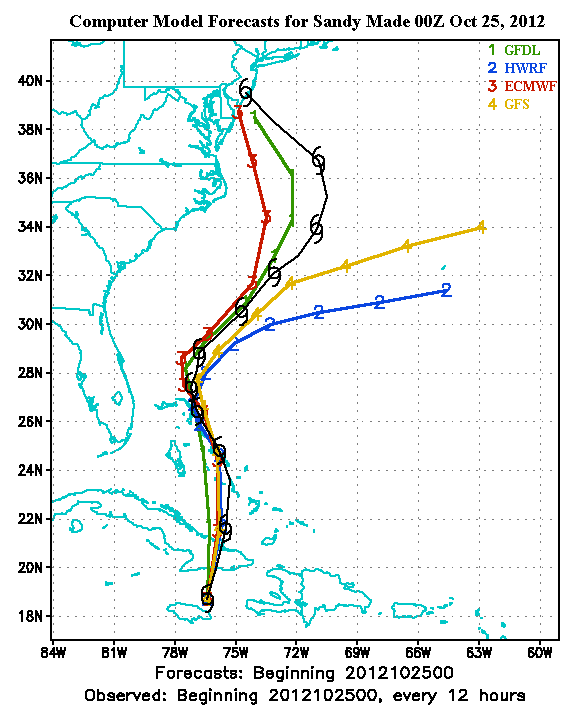Go to the Prior Tip
For Forecasts, Bet on Monte Carlo Methods
Go to the Next Tip
Goal Seek Method for Fast IRR Solutions
Return to MaxValue Home Page
By Jo Craven McGinty, "The Numbers" column, Wall Street Journal, S/S Aug 13-14, 2016
It is a pleasure to see decision analysis applications in the news.
This article looks at forecasts for Hurricane Sandy, which devasted parts of the U.S. East Cost during October, 2012. It became the largest Atlantic hurricane of record, costing an estimated $75 billion in damages and 233 lives (in eight countries).
Forecasting the path of a hurricane is important business. And Monte Carlo simulation is suited to the task.
Numerous scenarios were generated at random. A single-trajectory forecast is determined by path averages. This is likely augmented with judgments of experienced meterologists. The U.S. reasonably knew the hurricane's course about 72 hours ahead. The Europeans, with a long legacy of weather forecasting, knew perhaps a day earlier.
The article shows numerous tracks made by American and European models. The American's mean track trajectory stayed in the Atlantic, while the Eupean's mean track made landfall about Pennsylvania. "In the case of Hurricane Sandy, meteorologists ran 50 different scenarios (trials) with more than 10 million randomized variables."
I could not find a public-domain image to share with you. However, the tracks are similar to what we see often with scenarios projected with business and economic forecasts. Usually, because the computations are so much easier, we will have many more trajectories, and these are commonly summarized into several confidence envelopes. Some of the weather images, online, show only one confidence envelope, calling it a "cone."
Here is an image of successive forecasts, with each trace being the mean projection at the time.The black trace is the actual storm path.

Source: National Oceanic and Atmospheric Administration (NOAA)
The article inludes:
She closes with this advice: "As with any forecasting tool, the results of a Monte Carlo simulation can't garantee the future. But viewing myriad potential outcomes through the lens of probability statistics can help lift the cloud of uncertainty."
—John Schuyler, August 2016
Copyright © 2016 by John R. Schuyler. All rights reserved. Permission to copy with reproduction of this notice.